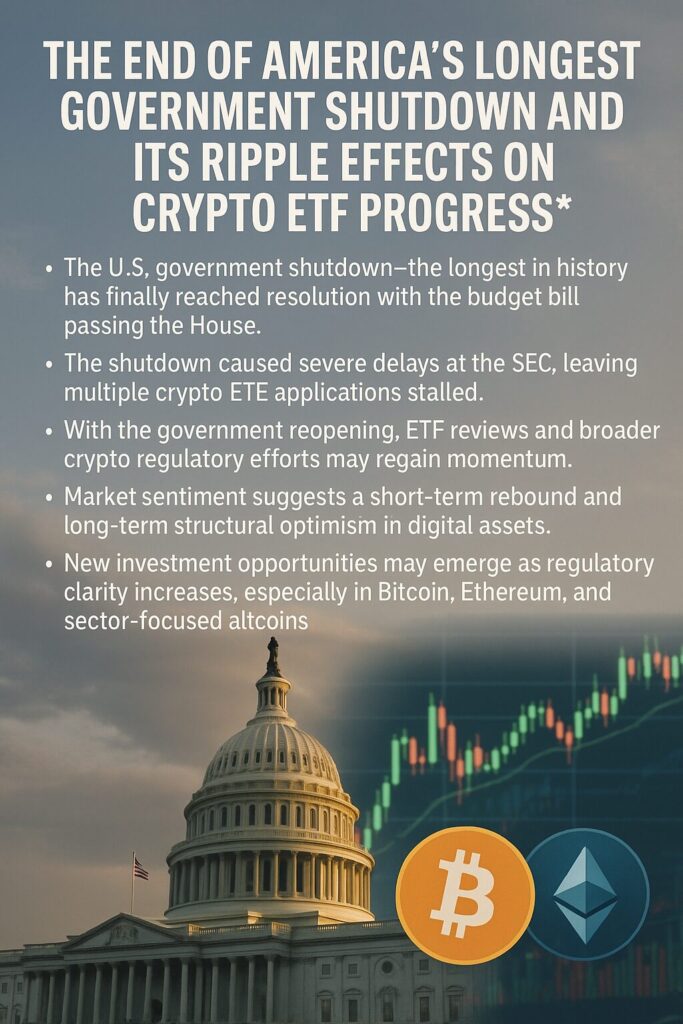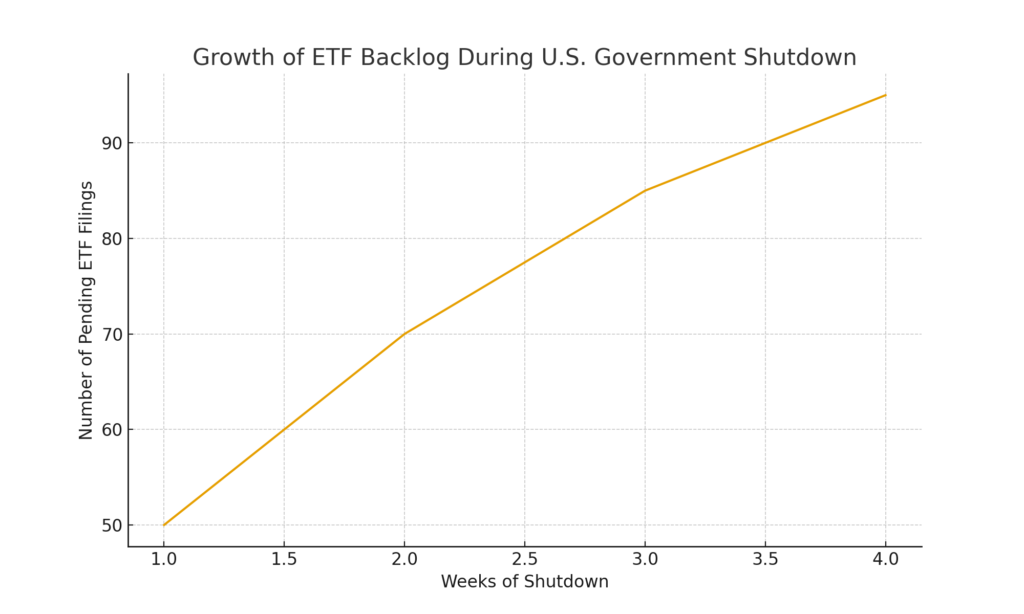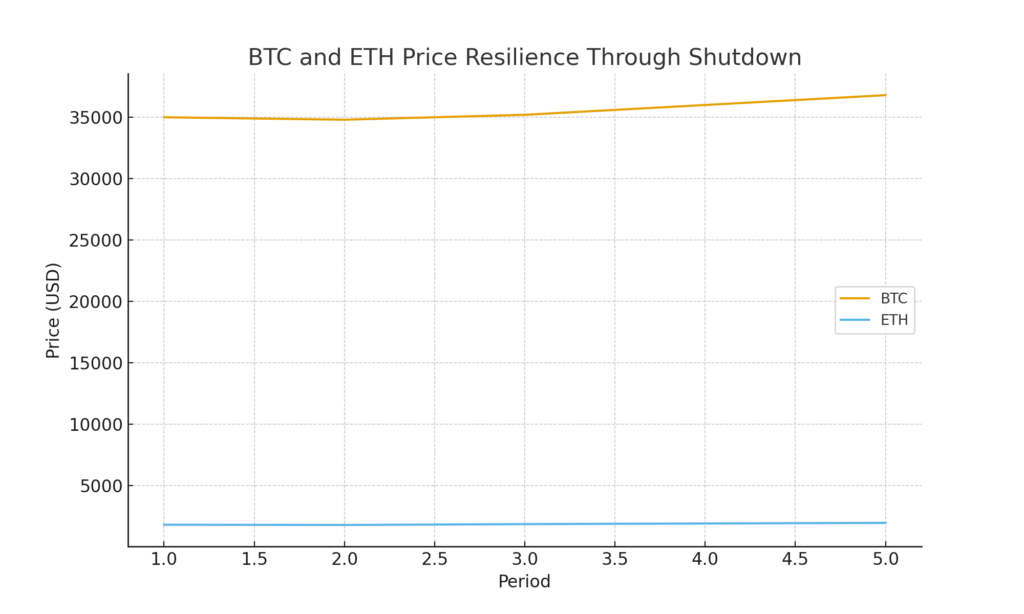
Main Points :
- The U.S. government shutdown—the longest in history—has finally reached resolution with the budget bill passing the House.
- The shutdown caused severe delays at the SEC, leaving multiple crypto ETF applications stalled.
- With the government reopening, ETF reviews and broader crypto regulatory efforts may regain momentum.
- Market sentiment suggests a short-term rebound and long-term structural optimism in digital assets.
- New investment opportunities may emerge as regulatory clarity increases, especially in Bitcoin, Ethereum, and sector-focused altcoins.
Introduction: A Historic Legislative Gridlock Finally Ends
The United States has reached a turning point as the longest federal government shutdown in American history appears to be ending. After weeks of political confrontation, the House of Representatives voted to approve a budget bill that will keep most federal operations funded until the end of January next year. The bill passed with 222 votes in favor and 209 against, marking a slim but decisive outcome.
President Donald Trump is expected to sign the bill, with reports indicating a signing ceremony planned for the evening during a dinner with business leaders. A statement provided to Fox News emphasized the administration’s expectation that Congress would unite behind a “responsible and sincere” solution to finally close the chapter on the unprecedented shutdown.
But while the political implications are widely discussed, another equally important dimension deserves attention: the shutdown’s effect on the digital asset industry, particularly the backlog of cryptocurrency-related ETFs at the U.S. Securities and Exchange Commission (SEC). For investors seeking new opportunities, and for builders advancing real-world blockchain applications, the shutdown represents more than a political inconvenience—it has created a bottleneck at the heart of the regulatory pipeline.
How the Shutdown Stalled Crypto ETF Progress

Regulatory Freeze on ETF Applications
The SEC plays a crucial role in determining the future of Bitcoin ETFs, Ethereum ETFs, and other digital-asset-based investment vehicles. However, the shutdown rendered the agency partially non-operational. With limited staff and halted non-essential activities, dozens of ETF applications—ranging from spot Bitcoin ETFs to diversified digital asset baskets—remained untouched.
ETF approvals are vital to the crypto ecosystem:
- They open doors for institutional capital inflows.
- They validate digital assets as regulated investment products.
- They expand market access through traditional financial infrastructure.
During the shutdown, issuers such as BlackRock, Fidelity, ARK, and other industry leaders faced indefinite delays. Analysts noted that even small procedural steps, such as comment period reviews or administrative updates, were left pending.
Market Impact of the Shutdown on Crypto ETF Momentum
Market participants closely watched the shutdown’s effects on liquidity and investor sentiment. Historically, delays in ETF reviews have created temporary uncertainty, especially among new retail participants and more risk-averse institutional allocators. During the shutdown, Bitcoin remained relatively resilient, trading sideways but avoiding deep corrections.
Still, the lack of regulatory progress created friction for emerging projects. For investors looking for the “next high-potential asset,” the regulatory bottleneck delayed:
- New product launches
- Institutional-grade custody approvals
- Clarity on rules for staking, tokenization, and stablecoins
With the government’s reopening, analysts anticipate an immediate pickup in pending SEC reviews, though the pace will depend on staffing levels and political priorities.
Political Divide: Democrats vs. Republicans on Budget and Policy
The House debate reflected deeper ideological divides. Democrats pushed for increases in healthcare spending and cost-of-living support, while Republicans insisted on reopening the government first before negotiating spending details. This standoff prolonged federal inactivity and disrupted multiple industries, including digital assets.
Though crypto is rarely the focal point of congressional spending negotiations, the shutdown demonstrated how fragile regulatory timelines can be. Even neutral agencies like the SEC halt most discretionary functions when federal funding lapses.
Where Crypto Legislation Stands Now
Potential Advancement of Market Structure Bills
Even during the shutdown, some bipartisan crypto market structure legislation continued informal progress behind the scenes. These bills—designed to clarify whether certain tokens belong under the SEC or the CFTC, improve exchange licensing standards, and define stablecoin rules—are poised to re-enter active negotiation.
If Congress prioritizes these frameworks in the upcoming session, the crypto market may experience:
- Greater legal clarity for token issuers
- Defined rules for custodians and brokers
- Improved consumer protection requirements
- A more efficient environment for innovation
For builders and investors, a more transparent regulatory landscape could unlock higher institutional participation, more compliant tokenization projects, and expansion of real-world blockchain utilities.
Short-Term Market Sentiment: What Reopened Government Means for Investors

Crypto markets responded cautiously but positively as news of the shutdown’s end emerged. Market sentiment appears to be trending upward due to:
- Expectations that ETF approval timelines will accelerate
- Renewed optimism around stablecoin regulation
- A broad rebound in risk assets as political uncertainty decreases
Bitcoin traded around the mid-$30,000 range during the period, while Ethereum hovered near $1,800–$2,000. However, what is more notable is the strong resilience of mid-cap and sector-specific tokens, such as those focused on:
- Layer-2 scaling
- Real-world asset tokenization (RWA)
- AI-based crypto analytics
- Decentralized finance (DeFi) automation
Investors searching for emerging opportunities may notice that these sectors tend to benefit disproportionately when regulatory clarity increases.
What This Means for ETF Applicants and the Future of Crypto Regulation
Immediate Effects
Now that the federal government is reopening:
- Pending crypto ETF filings are expected to resume and accelerate.
- The SEC may re-evaluate halted comment periods.
- Cross-agency coordination—such as Treasury involvement in stablecoin supervision—can restart.
Medium-Term Outlook
Regulators are likely to prioritize certain categories:
- Spot Bitcoin ETFs (strong political and institutional pressure to finalize)
- Ethereum ETFs, especially if staking-related issues are clarified
- Commodity-style token baskets, depending on how Congress defines “digital commodities”
Long-Term Implications
If ETFs become widely approved:
- New capital inflows could push Bitcoin and Ethereum into mature institutional asset classes.
- Traditional finance firms may accelerate tokenization of bonds, equities, and private credit.
- Compliance-friendly blockchains (including those optimized for payments and settlement) may gain new market share.
Investment Outlook: Sectors to Watch After the Shutdown

For investors seeking the next high-potential opportunity, regulatory momentum is often an early signal. Below are sectors likely to see increased growth:
1. Payment Tokens and Stablecoin Infrastructure
If stablecoin legislation progresses, tokens used for settlement and global transfers—especially those operating under compliance-friendly environments—may grow.
2. Institutional DeFi and On-Chain Derivatives
Legal clarity opens the door for traditional financial institutions to join on-chain markets, especially for:
- Tokenized treasury markets
- On-chain liquidity vaults
- Regulated derivatives
3. Layer-2 Networks and Rollup Ecosystems
As Ethereum scales, Layer-2 tokens benefit from rising transaction throughput and DeFi migration.
4. AI + Crypto Convergence
AI-powered trading, risk analytics, and autonomous agents represent a new frontier. Tokens supporting these ecosystems may see explosive growth as capital flows into AI-heavy verticals.
5. Real-World Asset Tokenization (RWA)
Tokenized U.S. Treasuries already exceed billions in value. Post-shutdown, regulatory clarity may accelerate corporate adoption, particularly for:
- Private credit
- Commodities
- Real estate
- Supply chain finance
Conclusion: A Critical Turning Point for Crypto Adoption
The reopening of the U.S. government marks more than a political milestone—it represents a crucial reset point for the cryptocurrency industry. With ETF reviews back on track, regulatory initiatives restarting, and investor confidence rising, the next few months may shape the long-term relationship between digital assets and traditional finance.
For investors searching for new assets, the end of the shutdown may unleash a wave of developments across ETFs, DeFi, stablecoins, and real-world tokenization. The combination of political clarity and renewed regulatory activity creates a rare window where informed participants can gain early positioning.
The crypto industry has long awaited this moment—not just for ETF approvals, but for a more predictable regulatory environment that allows innovation and investment to flourish. With momentum now restored, the next phase of blockchain adoption may be closer than many expect.

